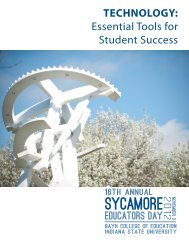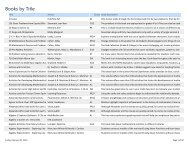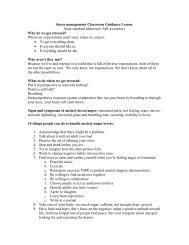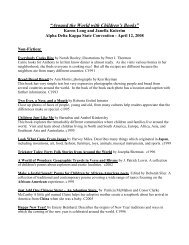Sycamore Educator Spring 2008 - Bayh College of Education
Sycamore Educator Spring 2008 - Bayh College of Education
Sycamore Educator Spring 2008 - Bayh College of Education
- No tags were found...
Create successful ePaper yourself
Turn your PDF publications into a flip-book with our unique Google optimized e-Paper software.
Indiana State University<strong>Sycamore</strong> <strong>Educator</strong>Student who struggled with reading earnshighest GPA honor at ISUIn second grade, Amanda Wilsonstruggled with her reading.Years later, she isn’t struggling anymore.Wilson was the sole Hines MemorialMedal winner for Indiana State University’swinter commencement. Theaward, named for LinnaeusNeal Hines, who served asuniversity president from1921 through 1933, is givento the graduating seniorwith the highest grade pointaverage.The Fort Wayne nativesaid she did her part to earnher grades by studying andcompleting projects to thebest <strong>of</strong> her ability. She alsoacknowledged the part thatothers played in her success.“I really have my family,friends and pr<strong>of</strong>essors to thank for theirsupport and encouragement while at ISU,”she said.When Wilson decided to study educationat ISU, she said it seemed like a natural fit.“After some reflection about my ownstruggles learning to read in second grade, Idecided that I wanted to help students whohave a hard time learning because a teacherdid the same thing for me, and I am sograteful,” she said.Wilson said herstruggles stemmed froma learning environmentthat didn’t help her tobe successful. However,when she moved toIndiana and beganattending a new school,her second-grade teacherspent time with herduring recess and sheoccasionally received helpfrom the special educationteacher.“By the end <strong>of</strong> secondgrade, I was beginningto read,” she said. “I was never labeled ashaving a learning disability because I justneeded more direct instruction than wasgiven to me in kindergarten and first grade.Reflecting back, I am so very grateful thatthose teachers gave me the intervention IAmanda Wilsonneeded to get me on track to be successfulthroughout my schooling.”Wilson decided to study education atISU because she said she was impressedwith its teaching program.“I was also interested in the opportunityto double major in both special educationand elementary education, and ISU was one<strong>of</strong> the only schools I found <strong>of</strong>fering a duallicensure program at the time,” she said.Wilson also completed the teachingEnglish as a second language programwhile at ISU. She hopes to be hired for aspecial education teaching position in theIndianapolis area.Wilson was recognized during IndianaState’s winter commencement.Written by Jennifer Sicking, assistantdirector <strong>of</strong> media relations.Making math available to all: Pr<strong>of</strong>essor helps to develop s<strong>of</strong>tware forvisually impairedIndiana State University associate pr<strong>of</strong>essor Elizabeth Joneshas spent the past seven months working to make math accessibleto all students.Jones, an associate pr<strong>of</strong>essor <strong>of</strong> mathematics and computerscience, took a sabbatical for the fall and spring semesters towork as a consultant with ViewPlus Technologies, a companythat creates hardware and s<strong>of</strong>tware for the visually impaired inCorvallis, Ore.John Gardner, a physicist who went blind as an adult, startedthe company to create products that would help the visuallyimpaired overcome obstacles in the way <strong>of</strong> education. Afterreceiving a National Science Foundation small business grant tocreate math s<strong>of</strong>tware for students, he contacted Jones to serve asthe math educator on the project team.“I feel very lucky to be doing this,” Jones said, adding that ithas been an “amazing” experience.“It’s made me think a little more about how to make mathavailable for all students,” she said. “As a mainstream matheducator, when I’m making curriculum, there are things that I justdon’t think about. Now, it’s on my radar and I’ll pass it on to mystudents before they’re thrown into it.”Currently, many visually impaired children are taught mathusing an abacus, Jones said.“We’re trying to move away from the abacus and get blind kidsdoing arithmetic the same way as sighted kids,” she said.With 75 percent <strong>of</strong> the visually impaired children inmainstream classrooms, Jones said it was also important todevelop math programs that could be used by all students. Theprogram they developed uses all three ways people learn: sight,hearing and touch.Through technology, a computer provides the voice forthe typed words and figures that are on a computer screen.An embosser creates print outs, with not only Braille, but alsographics that the students can feel.“The blind can touch it,” she said. “It can also be used by thelearning disabled who can see and feel it.”Students can take the printed page and place it on a touch pad,which is connected to the computer.14 http://coe.indstate.edu






